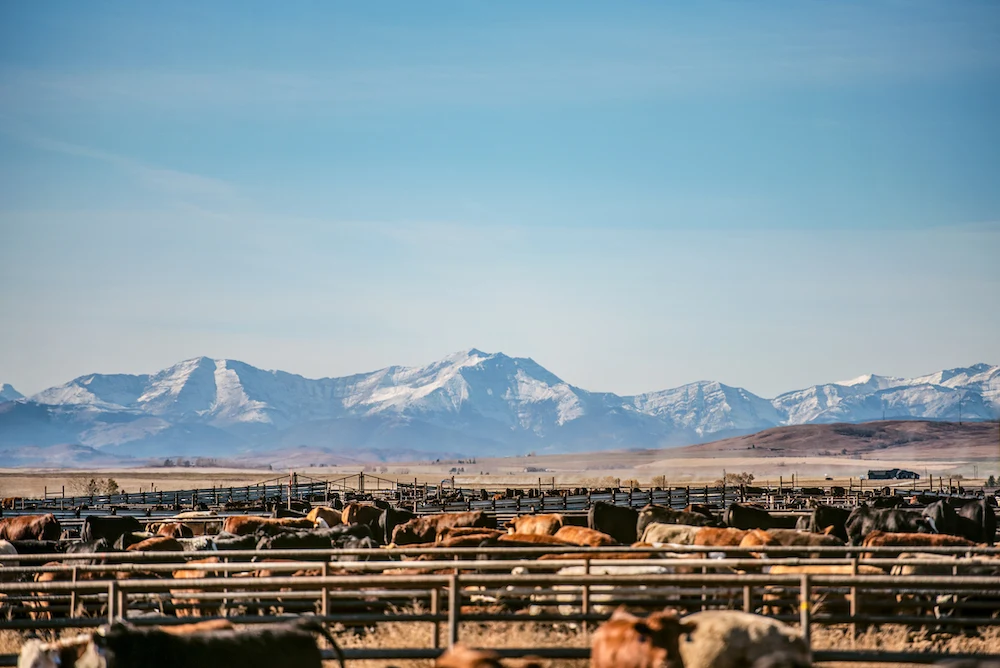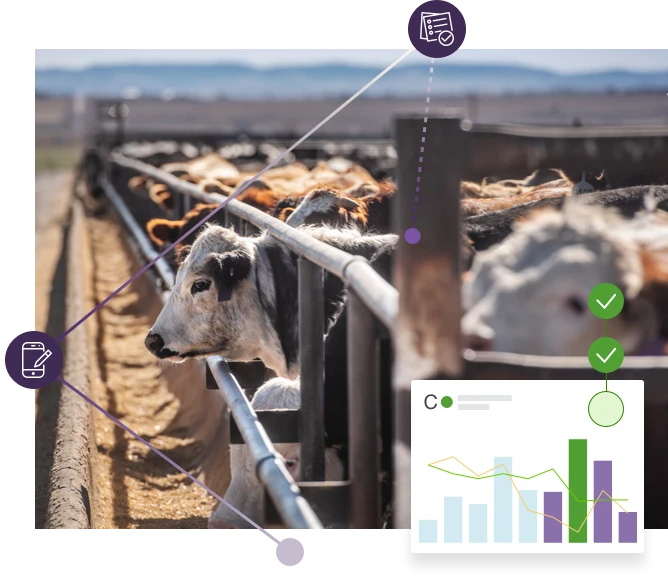Insights to improve the bottom line in the digital era of beef production

Feedlot managers regularly perform the closest imitation of a circus juggling act found in any sector of the beef production industry. They control and manipulate the figurative balls of inputs, commodities, inventories, health and treatment outputs alongside marketing realities and more, some of which threaten to burst through the stratosphere while others plummet to earth.
Keeping these elements airborne seems an impressive feat, until a ball like a winter blizzard or month-long heat wave randomly enters the spectacle, turning the barely contained mayhem into chaos.
The facts are the facts. Margins are narrow, costs rise and fall, moving pieces alternately accelerate and brake for oncoming obstacles, health challenges swell or shrink, and marketing becomes predictably unpredictable, just before wholly uncontrollable conditions reinforce the gravity of the situation.
Turning from generic applications to targeted decision making
Operators, no matter the experience level or ownership status, understand the generic, broad sweeping tactics required to point beef production in the right direction.
Cattle need consistent feeding and finishing on high grain rations but what does this mean regarding available inputs and their cost effectiveness?
They must be protected from disease and treated when sick, but how should a receiving protocol or treatment plan be formulated?
Lots using conventional beef production practices understand growth implants improve average daily gain (ADG) efficiencies, but which ones fit the circumstances and when should they be used?
Every dollar does count, but vast differences involved with ration makeup and delivery, vaccine and antibiotic costs, withdrawal periods, plus implant strengths and timelines exist.
“Generic solutions aren’t good enough answers to the many aspects and questions that affect the bottom-line,” says Calvin Booker, DVM, TELUS Agriculture, Animal Agriculture (Formerly Feedlot Health), General Manager of Services and Research. “Feedlots need options validated in large-scale field trials and tailored to individual production scenarios to translate the biological outcomes into dollars and cents.”
Shine a light on uncertainties
To offset uncertainty and cut through generic offerings, feedlot operators can depend on a feedlot health and production management program such as Feedlot Health by TELUS Agriculture to deliver customized software and service modules. When reviewing these types of programs, it’s important to take note of the strategies—including data analysis, research and consultant-provided insights—used to improve the bottom line. By employing a series of tailored service modules focused on specific areas of beef production, consulting veterinarians and Ph.D. animal scientists can target areas of need, breaking them down to exacting approaches.
“Feedlots position themselves for success when they use science-based feedlot health and production management programs developed, validated and continually updated by experienced veterinary and animal science professionals. This allows feedlots to incrementally improve - with confidence - over time,” Booker says.
From procurement, through production and marketing, consulting veterinarians and Ph.D. animal scientists draw from large-pen commercial trial data sets to deliver answers to broad, all-encompassing questions.
Ground-level digital technologies assist by creating the opportunity for frequent monitoring adapted to the operation’s needs. With the ability to connect digitally, remotely or virtually, they drill down to the core, gathering and analyzing applicable data for operation specific outcomes.
“Whether faced with health, nutrition, or production questions, data insights generated and tailored to a specific operation from animal health and production consultants with access to validated large-scale research, create tangible value for that feedlot operation,” Booker says.
Make animal health and production a priority
Offset uncertainty and cut through generic offerings
Purchasing with confidence backed by knowledge
Beginning with procurement, buyers regularly face uncertainty when evaluating groups of cattle as many aspects including health status trends, previous owner decisions, genetic limitations and long-term carcass characteristics remain largely hidden from sight. Generic onboarding tactics to compensate for these shortcomings may be wide ranging but will decrease return on investment simply by being ill targeted.
To fill these gaps, cost-effective strategies analyzing historical health, production and carcass characteristic data have been developed. By coupling this comprehensive economic modeling with extensive research studies, the resulting scientific methods paint a much clearer procurement picture.
Overall beef production clarity
Optimal production phases are often challenged by a myriad of arrival procedures, labor- intensive sorting practices, reactive feeding actions and marketing plans developed without ample time for effective strategies.
To counter these challenges, feedlot operators need to be able to depend on their feedlot health and production management program for built-in arrival protocols including vaccines, prophylactic treatments, parasite controls and performance products, all based on gender, weight, history, rations and finished marketing plans.
Sorting complications are eased with customized capabilities to help with grouping decisions, managing pen makeups by age, weight and breed to help pair feeding and marketing endpoints with consistent and desired carcasses.
Focusing the animal health picture
When addressing ongoing health issues, many yards are challenged with establishing treatment procedures, as limiting factors such as inadequate disclosure of treatment history, multiple treatment methods and unknown withdrawal periods combine to limit individual and pen successes.
Treatment protocols developed to realistically ease complex health challenges lessen negative impacts spreading from animal to animal and pen to pen.
“Ideal preventative measures, therapies and intervention protocols are based on specific information and data derived from scientifically valid, large-pen commercial field trials,” Booker explains. “However, the real value occurs when the right protocols are used in the right animals at the right time, and experienced animal health and production consultants are uniquely positioned to continually help producers with this process.”
Feedlots using proprietary and customized software and service modules maintain complete event histories while supporting all production, performance and health statistics in one location.
Matching movements with data transfer
Inconsistencies caused by individuals and groups moving within feedlots or during transfers can become problematic when information doesn’t travel with them. Histories may be lost, reasons for movements or treatments misplaced, and performance records skewed.
Feedlot health management programs are able to guide both single animal and pen movements, no matter the scale, and ensure that the data accompanies them. They accommodate retagging without history loss, provide a full pharmaceutical inventory system, and feature individual carcass file uploads.
Feeding with specific goals
When it comes to feeding, factors such as inadequate feed, mineral, and supplement choices —including commodities and processing methods—derail ADG, intake, conversion and efficiency. In addition, excess feed is wasted, and pen productivity is lost which can result in downstream impacts including reduced carcass yield percentage, weight, grade and marbling.
“Animal health and production consultants focus on all aspects of nutrition, including the relationship between feeding programs, health and carcass characteristics,” Booker stresses. “Replicated large-pen commercial field trials are pivotal for determining the actual biological impact of various ration formulations as opposed to relying on results of ‘standard’ prediction models.”
Accurate performance enhancements
Occasionally, feedlots experience a decline in quality and consistency, often due to ill-informed, non-compliant or poorly defined performance enhancement product use. This can snowball into loss of gain and efficiency, health challenges, inferior carcasses and may even invite noncompliance issues.
The key features of a feedlot health and production management program such as Feedlot Health’s Performance Enhancement Product Protocols incorporate enhancement technologies based on data collection and analysis from large-pen commercial field trials and research. Using this formal approach guides decision making and customizes recommendations for unique systems. Consulting veterinarians and Ph.D. animal scientists use these tools to maximize returns by applying implants, additives and other performance enhancement technologies.
“We understand there are vast differences in the cost and benefits of various implants,” Booker says. “Knowing the specific animal type and production scenario and customizing the implant program allows for optimal return on investment as opposed to using whatever implant program is convenient and familiar. ”
Additionally, feedlot programs are able to deliver regular marketing projections in real time which allow for straightforward sales and bookings, pre-harvest cattle protocols and shipment procedure management. Consultants streamline the selling process, applying data and scientific methods to improve net returns, plus they examine grid marketing options that can help provide the information necessary for risk management precision and more accurate marketing assessments.
With no shortage of generic ideas and hypotheses for various actions and their expected results, feedlot health and production management programs are able to combine customized software and service modules with large-pen commercial trials, testing and validation a vast array of possibilities at scale to help provide a more profitable beef production outcomes.
Contributed by Bruce Derksen, freelance writer

